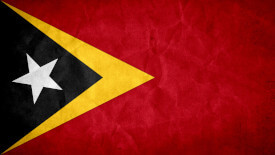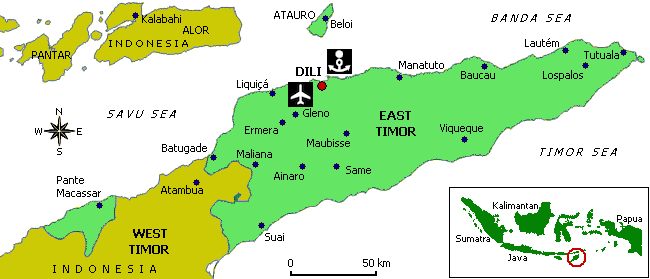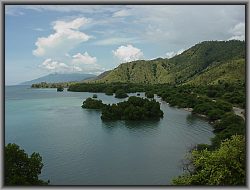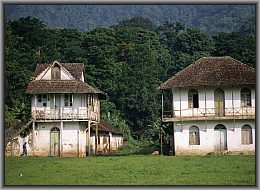
Setup & config options
Suitable power supply
RasPi & sFTP file transfer
Home network print server
Home network scan server
Mesh : home Lan USB drive
Explore hard & software
UFW firewall explained
Secured by fail2ban server
Software packaging & PPA
Apache 2.4+ LAMP server
https web server : port 443
Varnish caching proxy
Module : cgi & perl
Module : geoip
Modules : php & mysql
http*s error handling
Server : conditional logging
TL-domain & dynamic DNS
Webalizer log analyser
Defeat referrer spam
robots.txt & xml sitemaps
Server : .htaccess handling
The game & not the islands
Setup & config options
North Atlantic : Macaronésia
🚫 No ads & tracking
Mainland overview East Timor - Timor Leste
The snapshot on snapshot on East Timor - Timor-Leste
This is an older article which I wrote on a free subdomain provided by Wordpress many years ago.
11-Dec 2018

East Timor is the eastern part of the island of Timor, the enclave of Oecussi in West Timor, the island of Atauro off Timor’s northern coast and the small uninhabited island of Jaco off it’s eastern coast. It is around 600 kilomtres from Darwin, Australia and is nestled between Indonesia and Australia. Once part of the Australian continental shelf, Timor fully emerged from the ocean only some four million years ago, and is therefore composed mainly of marine sediment, principally limestone. Rugged mountains, a product of the collision with the Banda Trench to the north, run the length of the country, the highest of which is Mt Ramelau with 2963 m.
Travellers will experience some of the challenges the Timorese contend with on a daily basis, and that may be the best reason to visit. The tourism infrastructure is barely developed, yet there’s just enough for the adventurous to experience this beautiful place without undue travail. The diving is magnificent, the countryside superb and the people genuinely welcoming. And just as the locals have found ways to get by, you will too – which only makes your journey more rewarding.
Sure the roads are crap and getting from one place to another can take forever, but the flip side is that you’ll rarely be following in others’ footsteps. You can get into the unique cultural rhythm that combines European and Asian beats.
The overview map - East Timor, Timor Leste

The facts on history
Little is known of Timor before AD 1500, although Chinese and Javanese traders visited the island from at least the 13-th century, and possibly as early as the 7th century. These traders searched the coastal settlements for aromatic sandalwood, which was valued for its use in making furniture and incense, and beeswax, used for making candles. Portuguese traders arrived between 1509 and 1511, but it wasn’t until 1556 that a handful of Dominican friars established the first Portuguese settlement at Lifau – in the present-day Oecussi enclave – and set about converting the Timorese to Catholicism.
In 1642, Francisco Fernandes led a Portuguese military expedition to weaken the power of the Timor kings. Comprised primarily of Topasses, the ‘black Portuguese’ mestizos (people of mixed parentage) from neighbouring Flores, his small army of musketeers settled in Timor, extending Portuguese influence into the interior.
To counter the Portuguese, the Dutch established a base at Kupang in western Timor in 1653. The Portuguese appointed an admin istrator to Lifau in 1656, but the Topasses went on to become a law unto themselves, driving out the Portuguese governor in 1705.
By 1749 the Topasses controlled central Timor and marched on Kupang, but the Dutch won the ensuing battle, expanding their control of western Timor in the process. On the Portuguese side, after more attacks from the Topasses in Lifau, the colonial base was moved east to Dili in 1769.
The 1859 Treaty of Lisbon divided Timor, giving Portugal the eastern half, together with the north coast pocket of Oecussi; this was formalised in 1904. Portuguese Timor was a sleepy and neglected outpost ruled through a traditional system of liurai (local chiefs). Control outside Dili was limited and it wasn’t until the 20th century that the Portuguese intervened in the interior.
In 1974 Portugal acknowledged the right of the colonial territories under it’s administration, including East Timor, to self-determ ination and withdrew from East Timor. With the withdrawal of the Portuguese, civil war broke out between those who favoured independence and those who advocate integration with Indonesia. On November 28 1975 Fretilin declared the independence of East Timor. Two days later the pro-Indonesian parties also proclaimed the independence of East Timor and its integration with Indonesia.
On December 7 1975 Indonesia launched an invasion of East Timor. The international community subsequently adopted resolution 389 calling on Indonesia to withdraw without delay all of its forces from the territory and the respect the territorial integrity of East Timor and the people’s rights to self determination. The early years of the Indonesian rule resulted in heavy loss of life. Estimates of the number who died as a result of the conflict, including the famine and disease that accompanied the displacement of large parts of the populatiion, range from tens of thousands, acknowledged by Indonesia itself, to asmny as 200,000. The fall of President Suharto in May 1988 opened the way for significant progress diplomatically and in June 1998 President Habibie announced that Indonesia was prepared to give East Timor wide-ranging autonom.
East Timor will continue to rely on foreign money as it struggles to establish a viable economy. Gas and oil deposits in the Timor Sea have the greatest potential to help East Timor’s economy to develop without the assistance of foreign aid.
High in the hills above Dili is another resource: coffee. Some 50,000 people work to produce the country’s sought-after arabica beans, noted for their cocoa and vanilla character. Shade-grown and mostly organic (because few farmers can afford fertilizers and pesticides), Timorese coffee is prized by companies such as Starbucks, and production is increasing.
East Timor’s tourism industry has great potential, although there needs to be a perception of stability for numbers to grow.
The climate
Located in southeast Asia, the island of Timor is part of Maritime Southeast Asia. The local climate is tropical and generally hot and humid, characterised by distinct rainy and dry seasons. The capital, largest city and main port is Dili. The eastern part of East-Timor has been proposed as the first conservation area in Timor as it contains the last remaining tropical dry forested area within the country and it hosts a number of unique plant and animal species. The northern coast is characterized by coral reefs making it a scuba divers paradise.
Weather forecast for Dili, East Timor - Timor Leste
Weather forecast for Suai, East Timor - Timor Leste
Locations of interest
Atauro Island : The 140-sq-km island, which can be reached by ferry or fishing boat, stretches about 25 km north to south and is very thinly populated by 8000 people who mostly live in two villages on the island’s east side, where the only road is. Life here is hard and even in good times there’s just enough food to go around. But the flip side is that the isolation has also kept many of East Timor’s tensions of the last decade away. The atmosphere is very relaxed and, although it’s clear everyone is poor, they don’t seem desperately so.


There are two small and delightful places to stay on Atauro. At either you’ll have time to do virtually nothing while you work up the energy for some amazing diving, remote trekking or intensive reading.
The land is not densely wooded, large areas are arid and there’s little water. People get by with wells, and electricity is only found in the two main towns, Vila and Beloi, and then only for a few hours.
If you like a place where the water is so clear you can see the fish as you arrive, where you can stay in a simple, thatched beachside hut and where your day’s activities are simply up to you, then you’ll love Atauro, where days can turn into weeks.
Atauro is directly north of Dili, 30 km across the Wetar Strait. Its land is similar to the adjacent Indonesian islands of Alor to the west and Wetar to the east. The people are from three clans – the Adade, Humungili and Manroni – and as well as Tetun, they speak three local dialects.
Oecussi : This 2700-sq-km remote enclave, surrounded on three sides by Indonesian West Timor, a series of jagged mountain ranges and fronted by the sea, feels like one of the most peaceful places on earth. Oecussi’s sweet cocktail of wild beauty, isolation, a deliciously slow pace and the incredible warmth of the mostly Dawan population, whose traditional conical-shaped lopo and ume kebubu houses dot the landscape from the peaks to the shore, oozes serenity.
Pante Makassar is the main population centre, but its deserted, dusty, counter-intuitively wide streets see far more goat traffic than vehicular movement. The rest of the 50,000 or so inhabitants are huddled in traditional villages scattered throughout the coastal mountains and along the Tono River.
When Dominican missionaries settled here in 1556, Oecussi became the first Portuguese colony in Timor, and this is where Catholicism initially took hold on the island. Portugal moved its colonial capital to Dili nearly 200 years later, but Oecussi remains aligned with Dili, regardless of the fact that geographically, culturally, linguistically and economically, Oecussi actually has closer ties to Indonesian West Timor than East Timor. Alas, religion has once again trumped logic, and today, travel between these three distinct territories is a bit complex. Nevertheless, Oecussi is well worth a detour, and if you do make the effort, you will be handsomely rewarded.
Dili : Dili will play an important role in your East Timor trip no matter what your plans. This is the only place with any choice of sleeping and eating options. It’s where you’ll make all your plans for seeing the country and where you’ll buy anything you might need for your stay – if you can’t get it here, you can’t get it anywhere in East Timor. And it’s where you tap into the local ju-ju to find out what’s really going on here and in the rest of the country.




